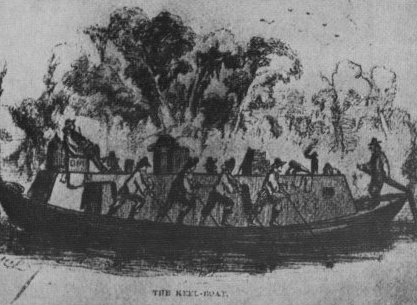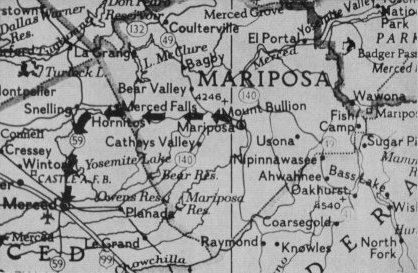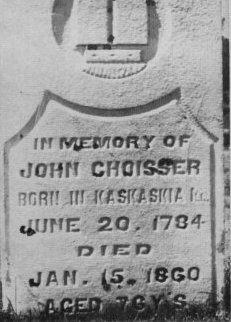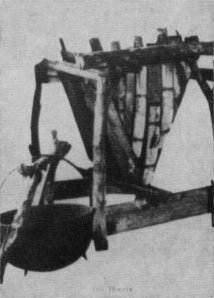An Illinois Family
By Lowell A. Dearinger-Part Two-
John Choisser
Michael Sprinkle seems to have been the first white man to settle in Shawneetown. This was in 1802.
At about the same time "a Frenchman, LaBoissiere" [Labuxiere] ran what must have been Shawneetown's first ferry. The evidence indicates that this French ferryman was a cousin of John B. Choisser, whose mother had been Marianne Labuxiere.
 | |
| OHIO RIVER keelboat such as the type on which early Illinoisans hauled produce and other material from the Illinois Country to New Orleans. |
John had started out on a keelboat trip to New Orleans. He had just pulled out into the stream when he spied a Nancy Sutton sitting on the grassy bank of the Ohio "combing her long brown hair." The New Orleans trip was delayed. At first sight he decided to meet and marry the girl with such beautiful hair. The two were married in 1809 - the year Shawneetown was chartered by Congress.
(Nancy's father was William Alpheus Sutton, a veteran of the Revolutionary War, who had recently brought his family from Virginia to Shawneetown, by way of Tennessee and Kentucky. The Suttons originated in a community of the same name in England.)
After his marriage John continued his keelboat trips to New Orleans. His last homeward trip, in 1811, was the most eventful of any he had spent on the river.
 | |
| WILLIAM CHOISSER, older son of John and Nancy, served as a lieutenant with Co. E, 29th Illinois Infantry during the Civil War. |
According to a family tradition John Choisser was financially associated with the salt works at Nigger Springs, also known as Great Indian Springs, near Equality. This may be the case, but available records do not confirm the tradition.
That John was connected with the salt works is indicated by Edward R. Roe, in his historical novel, "Virginia Rose, A Romance of Illinois" - published in 1800.
A Captain Rose tells of meeting at the salt works a voluble little Frenchman (Choisser) who, while the men roasted corn at the furnace fires, talked about the salt works and its history.
The Rose party was on its way to St. Louis. In those days the Indians were yet troublesome. Several forts had been built across the state, including Jordan's Fort, near Thompsonville (Franklin County). While traveling between these forts there always was safety in numbers. Consequently, when it was learned that the little Frenchman was leaving the next morning, also for St. Louis, they were very glad to avail themselves of his company.
John Choisser had a part in the founding of Galatia (Saline County). In an 1887 history we are told that for some years during the early history of Galatia the principal if not the only business men in the village were J. & T. (Timothy) Choisser.
Punch Choisser
In the last century it was not unusual for young men to go "out West" in quest of adventure and, hopefully, of a fortune. Adventure they found. Sometimes they found that fortune. But more often they returned no richer than when they left home.
To the townspeople, such an adventurer was endowed with an aura of mystery. Like Sinbad, he had been places. He had seen the elephant. He had done heavens knows what. And did the Mormons really have horns?
At least three of the 12 Choisser brothers were stricken with the fever for wanderlust. Some of William's family found their adventure, and, we hope, a fortune, in Forsythe, Montana.
 | |
| LAFAYETTE "Punch" Choisser, whose wild ride saved an innocent Indian. |
Somewhere in his travels, Lafayette had picked up the nickname, "Punch." In Bear Valley Punch was made constable, and deputy sheriff of Mariposa County.
Mariposa was a county of superlatives. It was one-fifth the size of all California. Here millions of dollars of gold was mined. Here lived epic figures: Gen. Fremont, Joaquin Murietta, the outlaw, and his side-kick Three-Fingered Jack. But Punch Choisser's race for life can be ranked with the deeds of these better-known celebrities.
The events leading up to the dramatic race read like Western fiction. In true western style, it began with a murder.
On May 9, 1878, while a Jonas Thompson was inspecting a walnut tree he had recently planted, he was felled with a shot by a hidden assassin. Thompson died that afternoon.
The killer had not been recognized. Consequently, when Indian Willie Rose happened to camp in the wrong place at the wrong time, the crime was pinned on him. Willie was arrested. He confessed, was tried, and was sentenced to life in the San Quentin prison.
There was some question about Willie's guilt - other murders, yet unsolved, had been committed when Willie had not been around. It was generally thought that he had confessed from fear of a vigilante group, calling themselves Rangers. These seemed hell-bent on a hanging bee, with Willie as the guest of honor.
It was an open secret that the Rangers intended to take Willie from the sheriff as he was brought from the Mariposa Court House. But the sheriff knew his job. Willie was boosted through a rear window, and turned over to Punch Choisser, who was waiting with two horses. Punch was to take the Indian to the railroad at Merced, 45 miles away, if the Rangers did not stop him.
 | |
| ROUTE OF PUNCH Choisser's ride for life. Note the proximity to Yosemite, in the gold country of California. |
Horses were changed at Hornitos. With the aid of a friendly liveryman the Ranger was delayed, thus gaining a few valuable miles. On leaving Hornitos Punch gave Willie an extra revolver he had been carrying, telling him to shoot straight, if need be.
Mile after mile they rode, pushing their horses at top speed. The pace was grueling for the animals, and dangerous. Should a horse stumble and fall, or a cinch break, then six-guns would determine who would reach Merced.
But Lady Luck, aided by good horses, was with Punch and his prisoner. The two reached Merced and Willie was safely lodged in jail by the time the Ranger arrived.
The 45 miles had been made in four hours, a record time yet remembered in Mariposa County. Punch was highly praised for the wild ride, and for risking his life with a prisoner and, considering the times, an Indian at that.
The next morning Willie was smuggled aboard the train. In due time Punch turned his prisoner over to the proper authorities in San Francisco. His responsibility was ended - except for one thing: he had forgotten to bring along the commitment papers.
Nancy and Mary Ann
Nancy Sutton, she with the long, brown hair, seems to have been independent minded.
The Suttons had objected to the marriage to John Choisser. He was a keelboat man and everyone knew that marriage vows meant little to such men. And besides, he was French. Why not marry a hard-working, dependable, American young man?
But Nancy was determined. As we know she married John, who turned out to be as hard-working, as dependable, and as successful as any "American" husband Nancy could have chosen.
 | |
| HEADSTONE of John Choisser in Wolf Creek Cemetery, Eldorado, proudly proclaims his birthplace, Illinois' once-leading village, Kaskaskia. |
When she visited her children, rather than eat from their coarser table settings, she always took along her own pink lustre china, and her own silverware. Moreover, she never could remember to cover the ash-hopper - a convenient excuse to cut short her visits.
Nancy died at Benton, June 25, 1876, while on a visit. She is buried beside her husband in the Wolf Creek Cemetery at Eldorado. For some reason her grave is unmarked.
Mary Ann, the only girl and the youngest of the 13 children of John and Nancy, was born March 20, 1832. She was educated in a Ste. Genevieve convent. When the Civil War brought about a shortage of doctors in Saline County, Mary Ann served her community as a mid-wife. Also, she read letters from husbands and sons in the army for those unable to read.
In December, 1850, she was married to William Henry Parrish, a young Saline County lawyer. To Mary Ann and William were born seven sons and two daughters. The oldest of these boys was a member of the first class of the University of Illinois - Class of 1867.
In 1860, Mary Ann and William built the first brick house in Harrisburg. The Parrish home now is part of the present educational building of the Methodist Church, at West Main and Poplar streets.
William Parish - one of the "r's" got lost somewhere in the Army records - served as Captain of Company E, 29th Illinois Infantry. Several of the Choissers served under their brother-in-law.
Members of both the Choisser and Parish families have been, and are, active in local and state politics, on both sides of the political fence.
 | |
| AN ASH HOPPER such as Nancy Sutton Choisser would forget to cover when visiting her children. Ashes were saved to leach lye, used in making soap. |
Several of the family drove over to Marion, and without much trouble found the grave. But it was a sober group which returned to Saline County.
This Kentucky twig of the family tree is seldom mentioned by the Elders. In fact, it seems that they regret the trip over to Marion. This Kentuckian had been - spare the word - a Republican!
Such political distinctions are yet very important in certain parts of southern Illinois.
In 1662, when Nicholas Brazeau and Perette Billard were married, our mid-West was yet an undiscovered wilderness. With this beginning, in three centuries - nine generations - Americans, according to Good Reading (September, 1967) have created more new wealth than all the more than two-billion people in the world. Furthermore, the benefits of this wealth have been more evenly distributed here than in any other country, at any time. Americans have gone further than any other people to spread literacy, enlightenment, health, general well-being, and good will throughout the world.
Despite the pride of ancestry, for such accomplishments the Brazeau-Choisser-Parish family has been no more than one drop of water in a bucketful. It has taken also your family, and mine, and generations of other families to make up the American body by which these things were done.
In this story of our Illinois family we are reminded that in the past, even as now, there have been crises and challenges; dark times and times of elation. And that today always is yesterday's tomorrow.
A look now and then at our heritage is a good antidote for the present, and a stimulant for the future.
THE END
ACKNOWLEDGEMENTS
|
Publications of the Illinois Historical Society. Illinois' Historical Collections. Jean Baptiste Choisser - Aubrey Starke. Jos. Sutton, Mt. Vernon, Illinois. Good Reading - Sept., 1967. True West. |
[ About the author, Lowell A. Dearinger ]
[ The Choisser Family Home Page ]
Copyright © 1967 OUTDOOR ILLINOIS Magazine, All Rights Reserved.
Published on the Internet with permission.